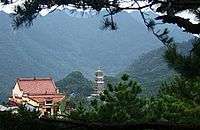Mount Jiuhua
Mount Jiuhua (simplified Chinese: 九华山; traditional Chinese: 九華山; pinyin: Jǐuhuá Shān; literally: "Nine Glorious Mountains") is one of the four sacred mountains of Chinese Buddhism. It is located in Qingyang County in Anhui province and is famous for its rich landscape and ancient temples.[1]
Many of the mountain's shrines and temples are dedicated to Ksitigarbha (known in Chinese as Dìzàng, Chinese: 地藏, in Japanese as Jizō), who is a bodhisattva and protector of beings in hell realms according to Mahayana Buddhist tradition. Pious Buddhists often visit Anhui to climb to Greater Tiantai peak, which is regarded as Jiuhuashan's most important peak, although it is not the tallest.
History

Mount Jiuhua was called Mount Lingyang in Han Dynasty. It was called Mount Jiuzi (九子山) in Liang and Chen Dynasties of South Dynasties. A legend says that the great poet Li Bai of Tang Dynasty travelled here and wrote down "Magic is divided to two branches, sacred mountain generates nine glories." (妙有分二气,灵山开九华). Thus it was named Mount Jiuhua.
JiuHuashan is delicately beautiful which is located in the southeastern part of Chizhou City, in Quingyang County of Anhui Province. The gross area reaches 120 square kilometers, while the protection area reaches 114 square kilometers. Shiwang Peak is the highest one with an elevation of 1342 meters above sea level. Together with Wutai Mountain in Shanxi, Emei Mountain in Sichuan and Putuo Mountain in Zhejiang. Jiuhua Mountain is called one of the four great Buddhist mountains in China. In 719 AD, Kim Qiaoque, a Silla prince (today's Qingzhou city in South Korea) came to Jiuhua Mountain and cultivated himself for 75 years. He died at 99 years of age, his corporeal body stayed intact. Because he was very similar in appearance to Dizang Buddhisattva, the monks there believed Dizang Boddhisattva was reincarnated in him, as a result, Jiuhua Mountain became the place to hold rites for Dizang Boddhisatva. During the golden periods of the Ming and Qing dynasties, there were as many as 360 temples and 4,000 to 5,000 monks and nuns. The mountain is not only famous for its Buddhist culture but also noted for its natural landscapes featuring old pines, green bamboo forests, strange rocks, waterfalls, streams and caves.
Mount Jiuhua was originally known as Jiuzi (Nine-Peak) Mountain. But ever since Li Bai, the celebrated poet in the Tang Dynasty wrote of the mountain,
Sailing down the Jiujiang River the other day, I saw the Jiuhua Peaks in the distance. Looking like a heavenly river hanging in heaven, Its green water embroidering cotton rose hibiscuses.
the mountain was renamed Jiuhua Mountain. As a popular pilgrimage destination, it was very famous in the southeastern part of China and became one of the four holy mountains of Buddhism. Since its opening in 1979, Jiuhua Mountain, with its abundant Buddhist culture and uniquely attractive scenery, has enjoyed a high reputation in southeast Asia, South Korea and Japan. It is known as the mountain of Dizang Buddhisattva and for having a large number of whole Buddhist relics. There are 99 peaks in the area, among them Shiwang Peak, Lotus Peak, and others.
Temples
Some renowned temples located at Mount Jiuhua includes:
- Huacheng Temple
- Guoqing Temple
- Dabeilou Temple
- Baisuigong Temple
- Qiyuansi Temple
- Roushen Temple
- Tianchi Temple
- Zhantanlin Temple
- Zhiyuan Temple
Gallery
 A view of China's Jiuhuashan (mountains), seen from a distance.
A view of China's Jiuhuashan (mountains), seen from a distance. Higher Daxiong Baodian, located on Greater Tiantai peak
Higher Daxiong Baodian, located on Greater Tiantai peak- Wanfo Pagoda at Mount Jiuhua
 China's Jiuhuashan (mountains): a view of multiple peaks, seen from Dizang Dian (temple).
China's Jiuhuashan (mountains): a view of multiple peaks, seen from Dizang Dian (temple).
See also
References
External links
| Wikimedia Commons has media related to Jiuhuashan. |
Coordinates: 30°28′56″N 117°48′16″E / 30.48222°N 117.80444°E